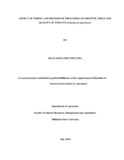Please use this identifier to cite or link to this item:
https://cris.library.msu.ac.zw//handle/11408/2462Full metadata record
| DC Field | Value | Language |
|---|---|---|
| dc.contributor.author | Chitanda, Muza Donater | - |
| dc.date.accessioned | 2017-07-04T07:52:46Z | - |
| dc.date.available | 2017-07-04T07:52:46Z | - |
| dc.date.issued | 2014-05 | - |
| dc.identifier.uri | http://hdl.handle.net/11408/2462 | - |
| dc.description.abstract | Tomato production is being limited especially during the rainy season due to the incidence of fruit rotting due to pest and disease attack. Due to the aforementioned limitation, modification of microclimate by trellising can assist improve crop yield. A 5*2 plus control factorial experiment in a randomized complete block design with three replications was carried out at Chiredzi Research Station in the 2013/14 rainy season in an open field environment to study the effects of timing and method of trellising on tomato yield and quality. Timing consisted of five levels: at transplanting, 2WAT, 4WAT, 6WAT and 8WAT while method of trellising has two levels which are trellis posts and Stake and weave. The control treatment for the experiment was no trellising. The study indicated that the highest number of days to 50% flowering was from timing at transplanting and 2WAT in both trellis posts and stake and weave methods while the lowest days were from no trellising but was not statistically different from 4WAT in stake and weave, 6 and 8WAT from both trellis post and stake and weave methods. Plant height at 50% flowering was highest for timing at transplanting and 2WAT in both trellis posts and stake and weave method and the least was from no trellising but was not significantly different from 8WAT in the other two methods. On number of fruits per plant, no trellising gave the highest number and trellis post the least. Trellis posts at transplanting and 2WAT gave the highest marketable yield and no trellising gave the least (t/ha) and on total yield, again trellising at transplanting and 2WAT in trellis post gave the highest total yield whereas the least was from no trellising, and timing at 8WAT in both trellis posts and stake and weave methods. The highest fruit sunscalds were observed from no trellising and stake and weave method gave the least affected fruits. Again, highest number of fruit rots were obtained from no trellising, trellising at 8WAT in both trellis post and stake and weave methods. Based on these results, trellising at transplanting and 2WAT in trellis post is recommended as the treatments resulted in the highest marketable yield. | en_US |
| dc.language.iso | en | en_US |
| dc.publisher | Midlands State University | en_US |
| dc.subject | Tomato production | en_US |
| dc.subject | Disease attack | en_US |
| dc.title | Effect of timing and method of trellising on growth, yield and quality of tomato (Solanum lycopersicum). | en_US |
| item.fulltext | With Fulltext | - |
| item.languageiso639-1 | en | - |
| item.grantfulltext | open | - |
| Appears in Collections: | Bsc Agronomy Honours Degree | |
Files in This Item:
| File | Description | Size | Format | |
|---|---|---|---|---|
| Chitanda.pdf | Full Text | 688.44 kB | Adobe PDF |  View/Open |
Page view(s)
274
checked on Nov 5, 2025
Download(s)
330
checked on Nov 5, 2025
Google ScholarTM
Check
Items in MSUIR are protected by copyright, with all rights reserved, unless otherwise indicated.



